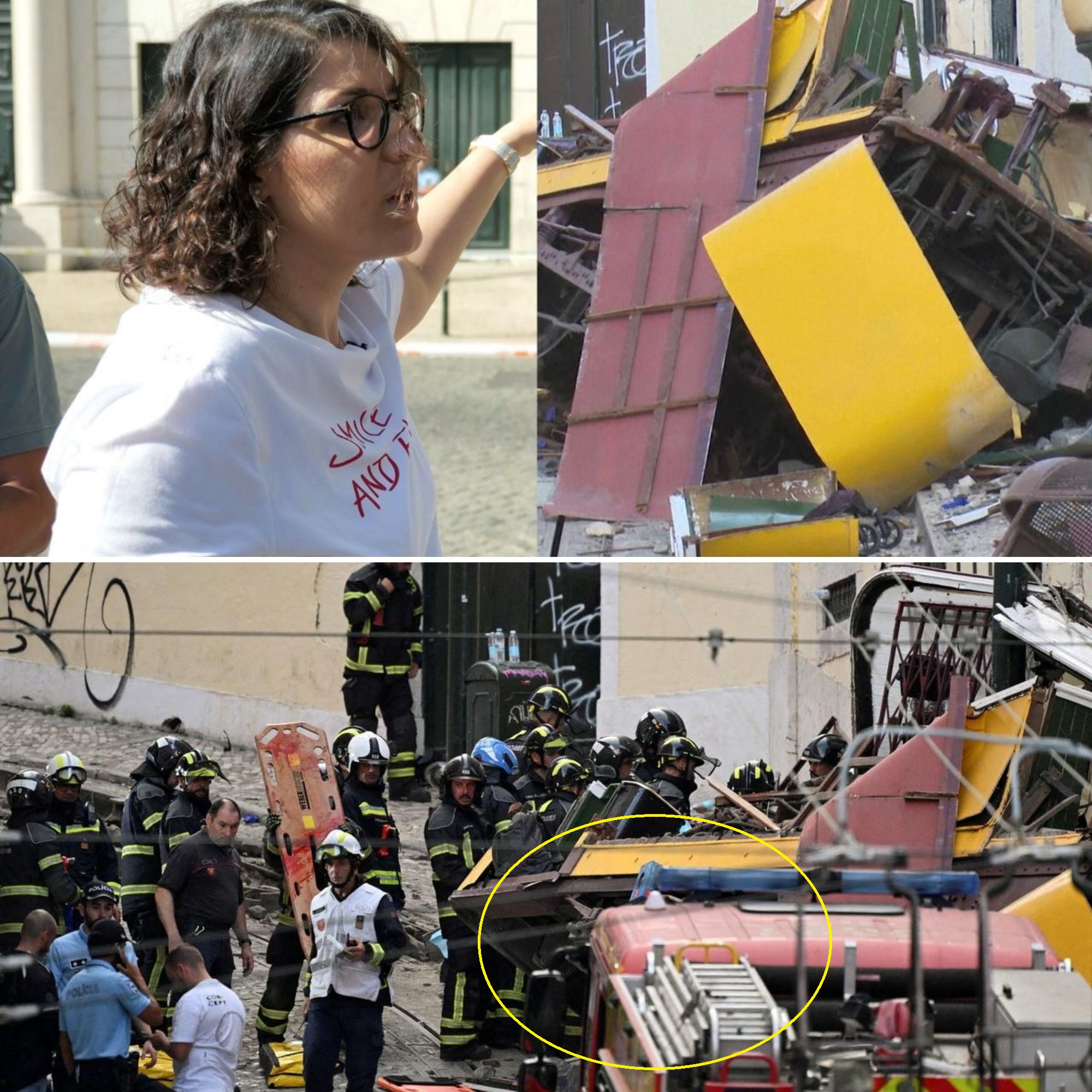🚨 TERRIFYING ESCAPE FROM LISBON’S FUNICULAR NIGHTMARE! 🚨
“We heard a strange screeching sound, and then…”—those haunting words from survivors of the catastrophic Glória funicular crash will send chills down your spine. 😱 What happened next turned a joyful ride into a scene of pure horror, with lives hanging by a thread. Can you imagine the panic as the tram hurtled out of control? Click the link to uncover the gripping survivor stories and the shocking truth behind this tragedy! 👇

On September 3, 2025, the Glória funicular in Lisbon, Portugal—a beloved symbol of the city’s charm—became the site of one of the deadliest accidents in its history. Just after 6:00 PM, one of the funicular’s yellow-and-white carriages derailed, hurtling down a steep hill and crashing into a building, killing at least 16 people and injuring 21 others. Among the survivors, harrowing accounts have emerged, with one chilling recollection standing out: “We heard a strange screeching sound, and then…” This article explores the survivors’ experiences, the details of the crash, the ongoing investigations, and the broader implications for Lisbon’s iconic funicular system, while critically examining the narrative surrounding this tragedy.
The Glória Funicular: A Lisbon Icon
The Elevador da Glória, opened in 1885 and electrified in 1915, is one of three funiculars navigating Lisbon’s steep, cobblestoned hills. Connecting Restauradores Square to the vibrant Bairro Alto district, the 265-meter journey is a tourist magnet, carrying about three million passengers annually. The system operates with two counterbalanced cars, each capable of holding 42 passengers, tethered by a steel cable and powered by electric motors. Its bright yellow carriages are a hallmark of Lisbon’s identity, making the crash’s impact all the more devastating.
The Crash: A Moment of Terror
The accident unfolded during the evening rush hour, as the funicular car at the top of the hill broke free, speeding uncontrollably down the track before derailing and smashing into a building near a bend on Calçada da Glória. Eyewitnesses described a scene of chaos: smoke billowed, metal crumpled, and screams filled the air. Emergency responders, deploying 62 rescuers and 22 support vehicles, worked swiftly to free trapped passengers, completing the effort in just over two hours. The death toll included five Portuguese nationals, three Britons, two South Koreans, two Canadians, one American, one Ukrainian, one Swiss, and one French citizen. Among the injured were a three-year-old German boy and his mother, with five in critical condition.
Survivors’ Haunting Accounts
Survivors’ stories paint a vivid picture of the terror that unfolded. Rasha Abdo, a Swiss tourist in the lower carriage, recounted to Sky News the moment her car began its ascent, only to jolt backward unexpectedly. “We heard a strange screeching sound, and then we saw the other carriage coming towards us at speed,” she said. Fearing a collision, her husband escaped through a window, taking their three-year-old son to safety before she followed. “When I went out, everything was dusty and blurry,” she added, noting the relief of narrowly avoiding the plummeting carriage.
Stefania Lepidi, an Italian scientist also in the lower carriage, suffered a broken arm when her car slammed into a concrete block at the track’s end. She described to Corriere della Sera the sudden backward slide and the eerie silence that followed the crash. “We all walked out of the carriage on our own two feet,” she said, reflecting on her luck compared to those in the upper carriage. Lying on bloodstained cobblestones for two hours, nauseous with pain, she witnessed rescuers prioritizing the most severely injured.
Another survivor, Abel Esteves, a 75-year-old Lisbon resident, was in the lower car with his wife and grandson. He told The Independent, “I told my wife: ‘We’re all going to die here,’” as the upper carriage barreled toward them before veering off and crashing. Esteves, who later assisted with rescue efforts, found one woman already deceased, a memory that haunts him. He vowed never to ride the funicular again.
These accounts highlight the visceral fear and split-second decisions that saved lives. The “strange screeching sound” reported by survivors like Abdo suggests a mechanical failure, possibly the cable detachment noted by the Lisbon Firefighters Regiment. This sound, followed by the chaos, underscores the suddenness of the disaster and the survivors’ narrow escapes.
The Cause: Mechanical Failure or Human Error?
The Lisbon Firefighters Regiment reported that a detached cable caused the funicular to lose control, a finding echoed by Michel Azéma of Funimag magazine, who noted the carriage “rolled down the slope at full speed and inevitably came off the rails.” Yet, questions linger about why the cable failed and whether the brakes—designed to prevent such catastrophes—were effective. The Fectrans union leader, Manuel Leal, revealed that workers had raised concerns about cable tension affecting braking, hinting at potential maintenance lapses.
Carris, the municipal transport operator, insists that all maintenance protocols were followed, with daily inspections, monthly and weekly programs, and a major overhaul in 2024. However, a 2018 derailment on the same line, caused by wheel maintenance issues, suggests systemic challenges. The cost of maintaining Lisbon’s funiculars has doubled over the past decade, raising questions about resource allocation and oversight. While sabotage has been ruled out, investigators are probing whether human errors—such as inadequate inspections or ignored warnings—contributed to the tragedy. A preliminary report from the government’s air and rail accident investigation office was expected on September 5, 2025, with a broader police report due within 45 days.
Critical Analysis of the Narrative
The focus on a detached cable and potential human errors risks oversimplifying a complex incident. Funiculars are intricate systems where mechanical, environmental, and human factors intersect. The Glória’s steep gradient and single-track design amplify the consequences of any failure. The “screeching sound” reported by survivors could indicate a cable snapping or brakes failing under strain, but without the preliminary report, speculation abounds. Blaming human error, as suggested by union concerns, may deflect attention from broader issues, such as underfunding or pressure to maintain high operational uptime amid Lisbon’s tourism boom, which saw 8.5 million visitors in 2024.
Survivors’ accounts also reveal the psychological toll. The trauma of hearing screams, as described by Teresa D’Avo, or witnessing the aftermath, as Mariana Figueiredo did, underscores the human cost beyond physical injuries. Figueiredo, a tour guide, told the BBC she rushed to the scene only to be met with silence, a stark contrast to the usual vibrancy of Bairro Alto. These stories challenge the narrative of a purely mechanical failure, highlighting the human experience at the heart of the tragedy.
Community and Global Impact
The crash reverberated across Lisbon and beyond. A makeshift memorial of flowers and a heart-shaped balloon grew at the crash site, while a mass at Saint Dominic’s church, attended by Prime Minister Luís Montenegro and President Marcelo Rebelo de Sousa, honored the victims. Among the deceased were André Jorge Gonçalves Marques, the funicular’s brake guard, and four employees of the Misericórdia de Lisboa Santa Casa charity, including Pedro Manuel Alves Trindade. The international scope—victims from 10 countries—prompted condolences from leaders like European Commission President Ursula von der Leyen and Spanish Prime Minister Pedro Sánchez.
For survivors, the psychological scars linger. The three-year-old German boy, pulled from the wreckage, and his critically injured mother face a long recovery. The UK Foreign Office and U.S. State Department are supporting affected nationals, reflecting the crash’s global reach. Lisbon’s other funiculars—Bica, Lavra, and Graça—were suspended for inspections, signaling a city-wide reckoning with safety protocols.
Implications for Funicular Safety
The Glória crash echoes past funicular accidents, like the 1999 Kaprun disaster in Austria, highlighting the inherent risks of cable-driven systems in steep terrains. Modernizing historic infrastructure while preserving its cultural value is a challenge. Lisbon’s funiculars, classified as national monuments, face the dual pressure of safety and tourism demands. The tragedy may prompt other cities to reassess their funicular systems, ensuring robust maintenance and emergency protocols.
Moving Forward
As investigations continue, Lisbon mourns its lost residents and visitors. The survivors’ stories—of screeching sounds, frantic escapes, and haunting silence—will shape the narrative of this tragedy. Carris plans to replace the destroyed carriage and reopen the Glória line, but rebuilding trust will require transparency and reform. The preliminary report, expected to clarify the cable failure and any human errors, will be pivotal in preventing future disasters. For now, the survivors’ courage and the memory of the 16 lives lost demand accountability and change.
Conclusion
The Lisbon funicular crash is a stark reminder of the fragility of even the most cherished urban systems. Survivors like Rasha Abdo and Stefania Lepidi, who escaped the plummeting carriage, carry stories of terror and resilience. The “strange screeching sound” they heard marks the moment a routine ride turned deadly, raising urgent questions about safety and oversight. As Lisbon heals, the world watches for answers, hoping this tragedy sparks reforms to protect future passengers on the city’s iconic funiculars.





